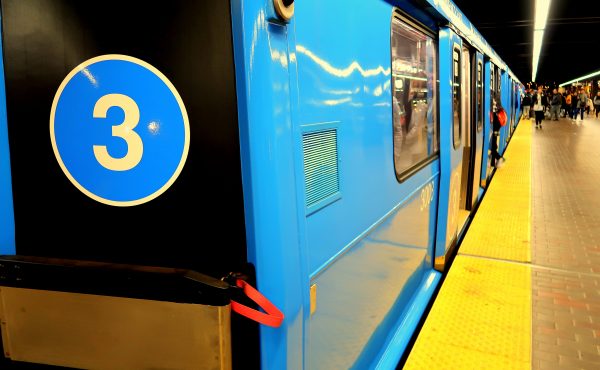
The past few months have been very exciting for Toronto’s transit users, with March’s announcement of the Transit City – Light Rail plan and the Provincial Liberal’s recent announcement of $17.5 billion over 12 years for various transit projects throughout the GTA.
In keeping with that momentum, the TTC has created a website, My New Streetcar and is holding a series of public events, giving Torontonians an opportunity to examine and provide feedback on an example of a Light Rail Vehicle (LRV), the type of which will eventually replace all of the TTC’s current fleet of streetcars.

A version of this Bombardier LRV (in Minneapolis colors) will be displayed at Dundas Square (south-east corner of Yonge & Dundas) on Thursday, June 28 from 12 noon – 8pm.
The TTC will also be displaying images of their current streetcar fleet, and as well as those of modern LRV’s at the following sites. The public is invited to comment on what they like and don’t like, as well as list their priorties for new LRV’s. In addition, TTC staff will be at the events to answer questions.
– Monday, June 25th (12 noon – 8pm)
Finch Station, one level below the bus terminal – 5174 Yonge Street
– Tuesday, June 26th (12 noon – 8pm)
Scarborough Centre Station, outside of the TTC station entrance – 300 Borough Drive
– Wednesday, June 27th (12 noon – 8pm)
The Albion Centre, Centre Court – 1530 Albion Road
For more information regarding the attributes of LRV’s, check out these links: Light Rail Now, the Toronto LRT info page and a primer on different transit modes.
photo rendering by Matt Blackett. Image of Bombardier LRV via tranist.toronto
NOTE: Although a Bombardier LRV will be displayed, it does not necessarily represent the vehicle that the TTC will be purchasing. There are rumours of other LRV manufacturers displaying their models at this year’s CNE, but nothing has been confirmed as of yet.




21 comments
All the billboards in the mystreetcar.ca video are turned into ads for transit.
My bets are on a no-contest Bombardier contract.
luke is right unless another bidder announces they will set up a line in the GTA in opposition to BBD’s Thunder Bay plant. Siemens did propose that for the subway but too late in the day. Even if BBD then win the contract the jobs might be repatriated to BBD Downsview rather than 800km away.
Personally I didn’t like this model when I saw it last year. I assume it’s the same model. There is very little seating compared to the current configuration, it doesn’t have low floors, and the seats are all at different heights which is… kind of weird.
I assume it’s the same one as last time but I’ll check it out, certainly.
If you’re talking about the Minneapolis cars, Bracken, it does have low floors and these LRVs will sometimes come in doubles — LRTs attached to one another.
My main questions is:
Can the TTC guarantee that the particular vehicle chosen will not require obsolete parts 20 years from now?
The TTC learned from the last sole source agreement. This time they’ll design an RFP so they can legitimately say that the contract was tendered in an open and transparent manner. However, I would guess that they include a “Made in Canada” clause in the RFP that will exclude all potential bidders except Bombardier.
I know exactly what Kevin Bracken means — I had the same reaction to the model I saw last year. It’s 70% low floor, but the other 30% gave the whole thing a very jumbled feel. And a lot of space is taken up by all the doors, so there really is less seating than you’d expect to find. (Minneapolis LRV: 94 feet long, 66 seats; TTC’s articulated streetcars: 75 feet long, 61 seats.)
As for sole sourcing, there are currently six bidders, mostly European. I doubt they’d be surprised by a Canadian content requirement; if the business looks substantial enough they’ll figure out how to make it work.
Is there a Canadian LRT-advocacy non-profit organization? Or should I just donate to Light Rail Now?
While Bombardier will probably get the contract (not that I mind supporting a good Canadian company), having the various LRT models on display at the CNE would be a nice throwback to the original spirit of the CNE: When people came from all over to see what’s new.
The City has already indicated that a Canadian content clause will apply – however even if BBD make them in TB that will cover assembly with some fabrication – many parts will come from abroad.
Leo – Transport 2000 is probably your best bet although they aren’t light rail specific.
I hope they do stipulate a ‘made in canada’ clause. who cares if another company bids slightly lower, we should be supporting our own economy and providing jobs for our own people whenever we have the option. and it’s not like bombardier is a second rate manufacturer. they make some the most advanced, and sought after transportation vehicles around the world. we are lucky to have them!
I remember reading if someone other then Bombardier gets the contract, they expect the winner to set up an assembly plant at the TTC’s Hillcrest facility.
marta,
it’s true that some BBD designs are good and maybe they will be best for Toronto – as long as Toronto doesn’t make itself fit BBD and instead BBD produces what Toronto needs.
If not, and Siemens or someone else can produce a better LRV in Ontario and preferably the 416 which needs the industrial jobs – bring ’em on.
The 70% low floor design is common in North American LRVs since it allows for higher top speeds — 60 mph or so. 100% low floor designs can’t go as fast. Speed matters on lines like Minneapolis where trains run in railroad-style rights of way to the suburbs. Toronto is more like European cities, where trains run slower in city streets and 100% low floor vehicles are common. As technology gets getter, the speeds for 100% low floor should be improving. Most suppliers, including Bombardier and Siemens, have built both types of vehicles.
i wish they would loose the streetcar and run electric buses. the weather in toronto is not conducive to streetcar tracks and we all know how often they have to re do them. the tracks are dangerous for cyclist and pedestrians. toronto should consider making queen st and king st one ways to help the flow of traffic. queen st one way to the east and king st one way to the west it would make sense. it would reduce traffic jams and the flow of the direction of queen and king would compliment richmond and adelaide. streetcar maintenance is a waste of our city’s money but the big business of contractors/construction workers and bombardier would not want to hear that!
for the last comment. Streetcars are more efficient then busses are. The king streetcar handles about 50 000 people a day where as the busyest bus route of Keele handles 30 000 people a day. Plus busses break down more often, are more suseptable to problems with tires and engines. Streetcars use less fossil fuels, require less overall energy to opperate. For your information, electric busses are ineficient and would need to be charged after one run. That would mean doubling of the bus fleet menaing more money spent purchasing busses. Plus streetcar traks are replaced about every 20 or so years, its just of late that you are seeing more track replacements beucase its time for them to be replaced. As regards to the tracks being dangerous to pedestrians and cyclists, it is not in any way, shape, or form. I have never heard of a person getting caught on the tracks, and cyclists just need to know how to go voer thme the rgiht way (aka perindicular to how the tracks run). Streetcars yeild te highest oppertunity costs from subways, busses comming in dead last for efficiency and dependability. Also in winter, busses run slower due to icy road conditions, streercars have a track they are pretty much stuck to, and can run faster and better.
electric buses dont need charging they run off of lines above your head we used to have them in toronto
and ever been to san francisco ? they do very well there! fyi in denmark they have started using rubber track for streetcars so peds and cyclist dont get hurt …. for your information james!
kiki,
The streets are so steep in San Fran that they would have a hard time using rail-based streetcars on them. In case you haven’t noticed, they originally had streetcars in SF, too, and still have them on some streets. In fact, they have one of the most multi-modal systems I’ve seen. As for rubber track, the Montreal Metro uses rubber wheels on their cars even though the right of way is entirely segregated…the application in Denmark might also have to do with public safety as well as noise attenuation from rail squeal (which is what Montreal, I’m told, uses it for).
Bombardier is the right choice. For the greater good of toronto and also thunder bay as well.
Toast
How exactly does choosing Bombardier serve Toronto? Thunder Bay I get. Toronto would be better served if another manufacturer pledged to set up a streetcar line in Oshawa, St. Catharines, Oakville or other southern Ontario towns devastated by the auto downturn. Thunder Bay can keep building our subway cars and GO Train carriages, and we need more of both of those anyway.